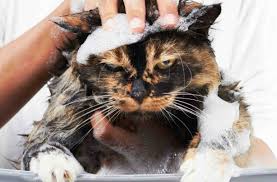
Should You Bathe Your Cat? When and Why It's Necessary
Share
Should You Bathe Your Cat? Full Guide for Cat Owners
Cats are famously known for hating water, but they are also one of the cleanest animals by nature. They spend a large portion of their day grooming themselves. So, do cats really need to be bathed? The answer is: it depends on your cat’s lifestyle, coat type, and specific situations. This article will help you understand when bathing is necessary and how to do it properly.
Why You Might Need to Bathe Your Cat
While most cats do a great job cleaning themselves, there are situations where human help is necessary:
-
Rescue or Outdoor Cats
If you adopted a stray kitten or your cat frequently goes outside, regular baths are essential—especially if they interact with other animals. -
Dirt and Contamination
Cats are curious creatures and may get into flowerpots, household chemicals, or food that could be dangerous if licked off. A thorough bath can prevent poisoning or skin irritation. -
Shedding Season
During shedding, long-haired cats can ingest too much fur, leading to digestive issues. Bathing helps remove loose hair. -
Thick or Dense Coats
Breeds with thick fur, like Persians or Maine Coons, may struggle to groom effectively and benefit from occasional bathing. -
Oily Coats
Some cats develop greasy fur due to skin conditions or diet. A mild shampoo can help manage this. -
Parasites or Skin Conditions
Medicated shampoos are necessary when dealing with fleas, mites, or fungal infections. -
Hairless Breeds (Sphynx)
Sphynx cats accumulate dirt and oils on their skin quickly and need regular bathing and wiping with damp cloths. -
Before Competitions or Events
Show cats should be bathed and groomed for a healthy, polished appearance. -
Environmental Factors
In polluted environments with poor water or air quality, bathing helps remove toxins from the fur and skin.

How Often Should You Bathe a Cat?
Bathing frequency depends on your cat’s environment and breed:
-
Indoor Cats
Once every 3 months is usually sufficient. -
Urban Outdoor Cats
Bathe every 1–2 months to remove dirt and pollutants. -
Rural or Farm Cats
Bathing 3–5 times a year is generally enough. -
Hairless Breeds
In summer: every 2–3 weeks;
In winter: every 4 weeks.

How to Bathe Your Cat: Step-by-Step
- Brush your cat thoroughly to remove knots and loose hair.
- Place cotton balls in their ears to prevent water from getting in.
- Prepare the bathroom — remove any objects that could fall or distract.
- Fill the tub or basin with lukewarm water (about 37–38°C / 98–100°F) up to your cat’s belly.
- Calm your cat, then gently place them into the water.
- Use a cup or jug to wet their fur, avoiding the face.
- Apply cat-safe shampoo, massage gently for 2 minutes.
- Rinse thoroughly with clean water.
- Dry with a towel or use a pet-safe blow dryer on low heat for long-haired cats.

Bathing Tips for a Stress-Free Experience
- Always use shampoos formulated specifically for cats. Human or dog shampoos may irritate the skin or be toxic if ingested.
- Try dry shampoo or grooming wipes if your cat dislikes water.
- Avoid bathing in cold environments or when there's no heating.
- Do not bathe pregnant or sick cats unless directed by a vet.
- When in doubt, consult your veterinarian for specific grooming advice.
Conclusion: Does Your Cat Need a Bath?
In most cases, cats don't require frequent bathing, especially if they’re indoor pets. But under certain conditions—exposure to dirt, parasites, medical issues, or coat type—bathing becomes essential for your cat’s hygiene and health.
By following proper techniques and using the right products, you’ll make the experience safer and more comfortable for your feline friend. Regular grooming not only improves cleanliness but also helps strengthen the bond between you and your pet.
